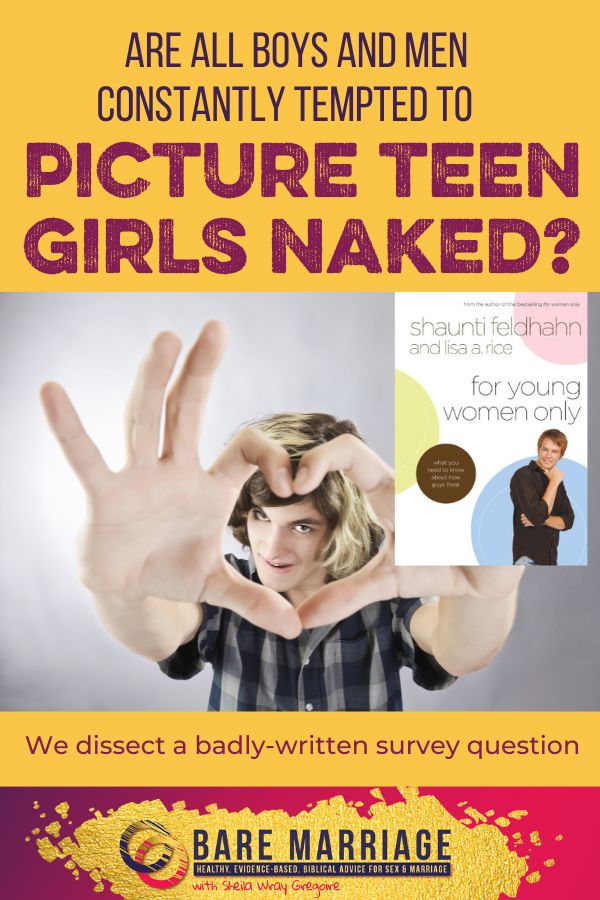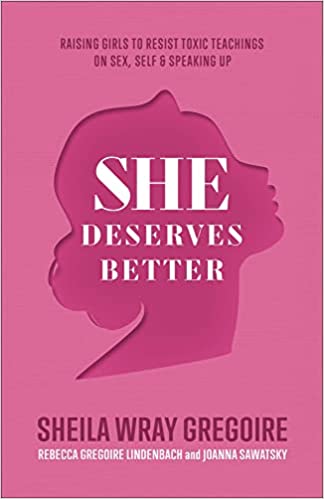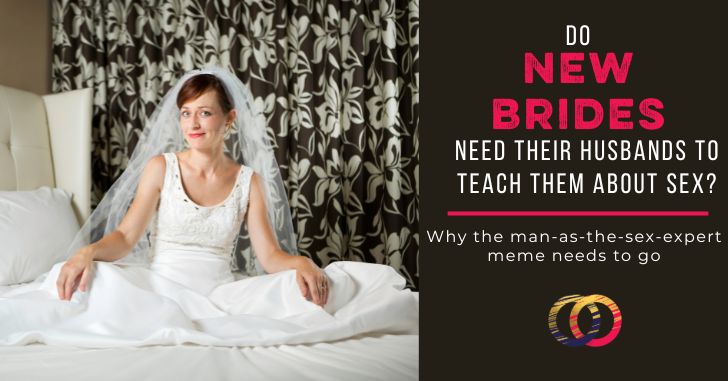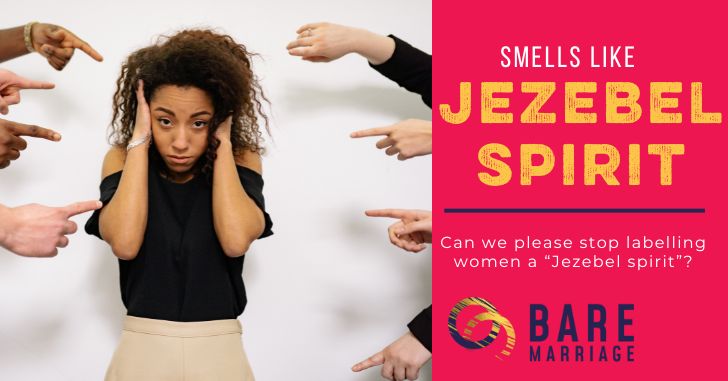Do boys have to fight constantly not to picture girls naked?
Yesterday on the Bare Marriage podcast (episode 183) we walked you through some of the problems that we discovered with the modesty messages that were given to girls as teens, especially during the purity culture era (mid 90s to 2010). So many of you said that you resonated so much with this one!
Our survey of 7000+ women for our new book She Deserves Better (out April 18) found that modesty messages were some of the most harmful, having long-term negative effects on women’s self-esteem, relationships, and marriages. Even on their faith!
And what’s worse is that the messages weren’t even true–or they were a distortion of reality.
They put the burden for men’s thoughts on women and girls, and made girls think that there was something inherently wrong with their bodies (as we talked about on the podcast yesterday, even 8-year-olds!).
Let’s look at the “research” that was used to teach girls that boys naturally picture them naked.
One of the biggest writers to girls during purity culture was Shaunti Feldhahn. Her book For Young Women Only, based on surveys she did of teenage boys, purported to tell girls how boys really think. (So that girls could adjust? The whole focus was off–why not teach what God wanted for us?)
But she also wrote so many articles for Brio magazine, and Focus on the Family frequently used her “research” as the basis for girls’ need to be modest.
Feldhahn was touted as one of the foremost researchers in evangelicalism, since she did surveys and she was Harvard educated (though not in anything that required statistical analysis or survey development, something she admitted in the first edition of For Women Only).
We’ve already looked at the deep problems with her survey question that was used to justify the idea that men need respect while women want love (even though they never asked women). And I have previously dissected one of her survey questions in the book For Young Women Only, showing how it enabled date rape, and showing the problems with her survey construction. Today I’d like to do something similar and take a look at one of the survey questions that was used to justify the claim: “85% of guys admit to the possibility of picturing a good-looking girl naked.”
This claim is made in her chapter, “Keeper of the Photo Files”.
It talks about how men and boys are visual, and they can’t help but look at “eye magnets”, and they have mental images stored of all the “great bodies they’ve seen.” The takeaway? Girls must dress so as not to draw attention to their bodies.
Let’s look at one such question, and how it plays out.
Question: “Now imagine that the same hot girl goes to the front of the class to give a report. She’s all business, but is wearing clothes that accentuate her figure. If you’re not careful, would there be a possibility that you would picture her naked–either now or later?”
And then what were the possible answers that boys could use?
What we did in our surveys was, as much as possible, use a Likert scale, usually a 6-question scale that ranges from Strong Agree all the way to Strongly Disagree. That way you aren’t leading in any way.
But that’s not what she did. Here is how boys could answer:

Okay, let’s dissect all of this, starting with the issues with the question:
She starts by using objectifying language.
The first thing she says is “hot girl.” She doesn’t say “attractive girl,” or “girl you find attractive.” She says “hot girl.”
The word “hot” implies sexy, and implies that she has a great body. It is inherently objectifying to say this about anybody. And it was even more jarring to say this back in 2006 when this book was first published than it is today even.
To tell teenage boys that they’re supposed to picture a “hot girl” is to tell teenage boys that it’s acceptable to think of girls in those terms. It’s to tell teenage boys, “it’s okay not to treat girls with respect, but to think of them as body parts.” It says, “it’s natural to objectify girls.”
The root of lust is not how women’s bodies look; the root of lust is thinking that it’s normal to objectify women and girls. And here Shaunti encourages boys to do that in the very survey question! Seriously, I find this absolutely infuriating, when she could simply have said something far more innocuous.
She acknowledges that the girl is not trying to attract attention.
She sets up the scene that this “hot girl” is not actually trying to attract his sexual attention, because she is “all business.” So what is the purpose of this question? It’s to tell girls that even when you’re not intentionally trying to provoke lust, you can.
So a girl is at fault even when she’s not trying to? Really? Is that the lesson we want to send?
She implies that the problem is that the clothes accentuate the girl’s figure.
Jeans and a form-fitting turtleneck can accentuate your figure. A tailored blazer can accentuate your figure.
If Shaunti is going to use this question to warn girls that wearing clothes that accentuate their figures makes boys picture them naked, then what are girls supposed to wear? Shapeless clothing?
This also insinuates that if a girl doesn’t have a curvy figure, she’s somehow not attractive and not a threat to boys, which is a problem in its own right.
RESULTS IN: Seriously leading questions
All of this results in a leading question. You start with saying she’s “hot”, then you tell a boy that she’s accentuating her figure. You’re already asking the test-taker to picture her figure. Then you ask if the test-taker might picture her naked–while you’ve already used words that make him think about her body.
Multiple studies have shown that when you prime test-takers to think about body parts, they tend to objectify more, but when you prime test-takers to think about the whole person and what she’s feeling and thinking, they don’t.
Now let’s turn to issues with the possible answers they could choose.
She doesn’t use a non-leading, objective scale
Proper survey design would now use a Likert scale for possible answers, looking something like:
- Strongly agree
- Agree
- Slightly Agree
- Slightly Disagree
- Disagree
- Strongly Disagree
Nothing is leading or prompting you to choose one or the other, and it’s a reasonable, easy to figure out scale. But that’s not what she does. She gives only three possible answers, ranging from Almost Definitely, Possibly, and never.
She uses four different qualifiers in her question and answer
Let’s count all the qualifiers that she uses for option 2, including the qualifiers in the question:
- If you’re not careful
- Would there be a possibility that you would picture her naked
- Either now or later
- Yes, possibly (answer 2)
So if you’re not careful, you might possibly have a possibility that you would picture her naked either now or later.
I mean, I would have to say yes to that. How could you choose no?
She leaves no room for likely not
66% of the possible answers say “yes, I would picture her naked”, and only one says no. Yet the “no” is definitely no–that would never occur to me. What about “likely not?
She makes one option “cool”
Compare the three different answers she gives:
- Yes, almost definitely (and even this survey question risks raising images in my mind)
- Yes, possibly
- No. That would never occur to me.
Do you see how #1 is the “cool” answer, while the other two are boring? It sounds like she wants you to pick #1. I cannot stress enough how terrible this survey design is.
Her first option is simply unethical.
We submitted all of our surveys to ethics approval through Queen’s University in Kingston, Ontario. We had to take ethics training before we could do so. And let me tell you–this question would never, ever pass ethics approval.
It is being asked of minors. And an adult woman is doing the asking.
Can you imagine asking a question to a teenage boy about a hot girl who is dressed to accentuate her body, and then ask if you picture her naked, and give him the option to say “even this survey risks raising images in my mind”?
Again, I can’t stress strongly enough how horrid this is. Teenage boys have a natural reticence to talk about their sexual fantasies and feelings with grown women, and that is a good thing. This survey question starts to blur that line, and that’s a dangerous precedent.
If you wanted to get to the bottom of how frequently boys picture girls naked, you could have done it in so many different ways. You could have simply asked a straightforward question:
Think of the last time a girl that you find attractive gave a presentation in the front of the class. During that presentation, did you picture her naked? (Yes, No, I can’t remember). After the presentation, did you recall her and picture her naked? (Yes, No, I can’t remember).
That’s matter-of-fact. This is not.
She never checked to see whether “picturing her naked” is a sexual thing.
What if human beings are just prone to picturing others naked out of curiosity, and not out of sexual desire? She’s using this question to say that guys are tempted to “linger on and fantasize about this great body he’s seeing.” But what if that’s not why they’re picturing you naked?
She would have needed two things: First, a follow-up question asking if picturing her naked resulted in fantasy and/or arousal; but also a question to girls asking if THEY pictured girls naked (assuming the girls were heterosexual). If girls were also picturing girls naked, then we can’t say that this is all a sexual thing.
This is the quality of research that the purity culture movement was largely based on.
No, Shaunti Feldhahn was not the only one teaching purity culture. But she was the main researcher in evangelicalism. When Brio magazine told you that boys can’t help but picture you naked when you accentuate your figure, this is how they got that information. And as recently as 2019, Shaunti was still spreading this message, in an article called “Letter to Our Teenage Daughters”:
When that guy sees you—this attractive girl who is drawing attention to her figure (even though you may not think of it that way)—a part of his brain called the nucleus accumbens is automatically stimulated. Instantly, even the most honorable guy is instinctively tempted to want to visually take in, linger on and fantasize about all the details of this great body he’s seeing. That doesn’t mean he does that (we’ll get into that in a moment), but he is instantly tempted to.
Even if he doesn’t want to be tempted. Even if he wants to be honorable and not think of you that way.
And he’s not the only guy in the room. So if you dress in a barely-there outfit, not only your date but every other guy in the room (and not to freak you out, but EVEN the dads who are there at the picture party) sees you, notices how little you’re wearing and has the same temptation.
Even the dads who are there. Even the adult men.
My husband never pictured our girls’ friends naked. He just didn’t. He gets so enraged by this sort of stuff (and he’s also a pediatrician!). I would never, ever let my daughters go visit a friend whose father was tempted to picture her naked. I just wouldn’t.
We told teen girls that because of their figures, boys would picture them naked.
We presented this as normal. We blamed it on what girls were wearing. We told girls they couldn’t expect anything else, even from the adult men around them.
And we said it was even accentuating their figures, even if they were “all business.” Even if they weren’t trying to draw attention. Even if you had no intention. You were still a threat, a problem.
It wasn’t the boys or the men who were the threat.
It was you. Because of your figure, which you can do nothing about.
This was wrong. And I hope you can see how horribly, horribly this research was that undergirded the whole thing.
And I hope you will agree that our daughters deserve better.
Check out our book She Deserves Better, which covers the problems with the modesty messages, and the long-term effects on girls! It launches April 18, but you can pre-order now!
Your daughter deserves better than what you likely grew up with in church.
What would it look like to prepare the next generation without toxic teachings about modesty, sex, or consent, and instead set her up for a big faith?
Pre-Order Now! (Helps us out a ton)
And if you email your receipt, you’ll get special pre-order BONUSES

What do you think of this survey question and answer? How did this all get so out of hand? What’s a better way to talk about it? Let’s talk in the comments!
















One of the things I say is that it isn’t enough to read the conclusion and the top-line results m; you have to know enough to understand the flaws in study designs.
That is a horrible question. It’s gross and it’s also incredibly leading.
My academic basis for understanding leading “survey” questions is criminal law. It comes up a lot on victim or bystander identification of a perpetrator. If the cop who is conducting the lineup thinks that #4 in the blue hoodie did it, he’s going to consciously or subconsciously lead the witness. “Are you sure it’s #3? You mentioned him being tall.” Witness tentatively says that it could be #4, police officer glows. Yay, witness got it right!
Worse still, this cements #4 in the witness’ mind. The witness will be very certain at trial that this person is the person she saw.
Is there an analogy to leading survey questions like that? Young boys who would not have pictures their classmates naked now do so because it’s the “right” answer? Curious is anyone has done research in this area.
PS – Harvard Kennedy School is a fine institution, but I laugh every time Shaunti just says “graduate degree from Harvard.” Harvard is enormous and has a slew of graduate schools, and Kennedy isn’t that hard (relatively) to get into or to complete. It’s still a fine institution, don’t get me wrong, but it isn’t like getting a degree from their med school.
Making up research results to teach what you want to teach.
And you want to teach that men are hapless idiots because they have a penis, while also upholding the teaching that only men can lead because of the aforementioned penis.
Cognitive dissonance, much?
Sorry, button press fail. Should have been standalone, not a reply to the always brilliant Jane Eyre.
She seriously claims this garbage is ‘research’?!!! It’s the classic ‘don’t think of a hippo’.
“If you’re not careful, is there a possibility that at some point, now or in the future, you may picture a hippo in your mind?”
Anyone who answers ‘no’ is either lying or has no idea what a hippo is.
Hahaha!!
“All Men Secretly Attracted to Hippos, Survey Finds”
Gold! 🤣🤣🤣
As well as agreeing with everything you say about how wrong this is, I also love how you simply but thoroughly educate all of us about research and survey design, and explain it so that we can understand and explain it to others.
It sounds like such a simple thing, yet in a world where facts and research get so distorted and people make disagreement personal, this is so necessary!
It’s very true that the way in which you ask the question and/or define the possible answers can affect the outcome.
I can only speak for myself. Sometimes I do and sometimes I don’t. When I do, sometimes it leads to a fantasy, and sometimes it doesn’t. My guess is that this depends more on sex drive and libido type than gender. A person with a high sex drive and spontaneous libido is likely to conjure up images far more often than a person with a low sex drive and responsive libido.
I can also only speak for myself, but I can’t remember the last time I pictured my wife naked (when she wasn’t actually) let alone a random woman on the street. And we have sex at least 3 times a week normally so I don’t think it’s anything to do with my/our libido. I guess I’ll just never be able to understand men because I don’t have that visual nature…
To be clear, not suggesting this makes me better than anyone else. Different people struggle with different things etc. But like Keith I’m sick to death of “all men do this or that” and the way it’s used to excuse bad behaviour in the church and society in general.
Also, I think there’s a more general survey design principle we can call on here. If your survey shows that 100% of *anyone* do *anything* that isn’t an absolute biological necessity, you’ve probably screwed up.
Very true, Tim. If I do and you don’t, that doesn’t make either of us more or less noble, or more or less of a “real man”.
While there may be general biological trends, ultimately we’re all different
Exactly.
Tim, that last bit is so true! (as is the rest, but let me comment on the last bit). Shaunti tends to come up with numbers like “85%” or “82%” or 89%” in her surveys. Why she didn’t see that as a red flag is beyond me. If you get more than 2/3 of people saying anything it’s worth a second look.
I bet she’d take a second look if it was 80+% against her theory. But we can all be guilty of that.
There’s a great story I heard about Archie Cochrane (grandaddy of evidence-based medicine) who did one of the first proper modern clinical trials looking at outcomes for cardiac patients. He basically found that the standard treatments at the time were worse than doing nothing, but when he presented the findings to his colleagues he deliberately switched the graphs around so it looked like the treatment group was clearly better. The other doctors basically said “we told you so – our treatments work and continuing your trials is unethical”. Then Cochrane showed them the correct graphs and challenged them on whether continuing the existing treatments could be ethical, given the results.
You could say it’s a bit of a cheap trick, but I think we all need someone to do something like that for us from time to time.
Wish I could remember where I read that. I think it was in Bad Science or another of Ben Goldacre’s books.
i love that story! So much is named after Cochrane now too.
Shanti’s survey is another example of spiritualizing bad male behavior and blaming it on females. Long before I ever knew that purity culture was a thing and I was not yet a Christian until 1994, I thought most guys pictured attractive females naked. At least, that’s what mainstream culture taught us and even in junior high sex-ed classes, us girls were told that guys are more visual and we must be careful what we wear. If we’re not careful what we wear, we’ll get ogled at because guys just cannot help it.
Then to find out that “Christian” resources echo these same things just confirmed to me (as an adult) that I must be careful what I wear. I don’t want creepy men ogling me. Well, it does not matter what I wear. There are always creepy people that stare regardless of what someone of the opposite sex is wearing.
These “Christian” resources need to STOP spiritualizing bad behavior in males!
Isn’t the entire point of Christianity that we shouldn’t spiritualise sin and things of the world? If that’s what you wanna do, plenty of other religions will help you out on that. Christianity frowns on it, though – otherwise, we wouldn’t need Jesus.
Yes, exactly. They put a “jesus-approved” stamp on all these horrible messages!
The sad thing is how many people really believe Shaunti’s books are research based. Recently a group of women from my church were discussing potential books to read together. One person suggestion FWO “because it’s based on research.” It took a lot of self-control not to say anything at the time, because I wanted to gather my information before countering her statement. Luckily the conversation moved on, and and Shaunti’s book wasn’t brought up again. But I would like to be better prepared if the topic comes up again in another setting.
And what is said “hot girl” supposed to do with this information? Become less “hot”? Or….. maybe…. we could teach boys that their thoughts are their responsibility, and it doesn’t necessarily mean that girls need to change anything.
Also, for the record, and I can only speak for myself, whether I engage in that or not, and whether or not it leads to more thoughts, generally does NOT depend on what they’re wearing or how “hot” they are.
In other words, I’m doing it myself. Wicked, unsubmissive temptress Jezebels are NOT making me do it.
I appreciate your perspective, Nathan. You’ve brought much needed understanding to this issue.
Thanks. I try to be honest about myself, warts and all.
Those poor boys.
I’ve been in a similar place.
When I was 15-16, I had an adult (my therapist at the time) ask me, “what are you going to do if you’re dancing with a boy and you feel his erection?” (In the context of: this therapist wanted me to remain a virgin. I didn’t even really talk to boys). He did a lot of stuff like that. I didn’t escape for 10 years, because I didn’t realize he was wrong, since “research” like this told me that it’s TOTALLY NORMAL to have adults sexualize you when you’re a kid.
Being treated like that can really mess you up.
I hope those boys are ok. I’m praying for them.
I get so tired of these proclamations that purportedly (even implicitly) proclaim glaring differences between male and female desire, when they only survey people of one gender – males.
“Results” like this make it seem like teenage boys are the outlier/other because they envision girls naked all the time. What if hetero teenage girls envision boys naked just as often? Did anyone ask them?
There seem to be a million studies about men’s desire and practically none about women’s desire. When they do ask both males and females, the study questions seem absurdly biased, like the one a while back with a woman in a tiny bikini being somehow visually equivalent to a man in oversized board shorts.
The upshot is that, between bad survey questions and one-sided surveying, people are led to believe that men have a monopoly on desire, sexual attraction, fantasy, etc. My entirely unscientific opinion, based only on observation of people in general, is that this is false. All humans experience a range of sexual desires and fantasies. It is not restricted to one gender.
Normalizing desire and freeing it from a gendered construct would go a long way to a more healthy sexuality, and would help all Christians learn to manage their sexuality and desire in a loving, Christlike way.
Yes, this is a huge problem with her research. She actually did survey teen girls too, but she asked them entirely different questions (we may do a podcast just on the differences, because it’s fascinating to look at the assumptions there). When we did our surveys, we asked men and women virtually the same questions where we could. Word for word.
“Even the fathers in the room…”???!
Eewwwwwwwwwwwwwww…
I know! It’s unbelievable.
I haven’t read the book thankfully. Does she say what her motivation is for writing this? What is her end goal?? Makes my stomach turn to even say this but does she only have sons and a husband she is trying to “protect?” Does she have a daughter? What does she think traumatizing girls is going to ultimately accomplish? This is so bizarre.
I’ve been trying to figure that out too!
This is all soooo true. As a 33 year old mom of two girls, I am just now learning how much this stuff messed me up as I am trying to weed through what I want to teach my wonderful daughters about modesty. Although the teaching on modesty from her book and others did protect me in some ways (I was afraid to wear anything even slightly form fitting or skin revealing for years because I didn’t want to be a temptation), it also gave me a sense of shame about my body. I’ve come to realize that one of the reasons my husband and and i have struggled so much with sex in marriage is because i have such a deep sense of shame about my body, believing that having a female body is somehow a problem. And that men are hungry sexual predators and something to be afraid of, unless I’m completely covered up at all time. It has deeply affected me in a way that has made it very hard to be confident and free with my husband sexually despite our loving, nurturing marriage. Really he is the one that has been helping me heal, as he is an honorable man who believes men are responsible for what they think and do and it’s not always a women’s responsibility to “protect them.” As I am working to undo these beliefs I am praying I can do so much better for my girls!
These survey questions have always reminded me of Xander from *Buffy the Vampire Slayer*–“I’m a teenage boy, looking at linoleum makes me think about sex.” It’s not what he’s looking at that’s the problem. (And at least Xander understood consent and wasn’t held up as the only “real” male.)